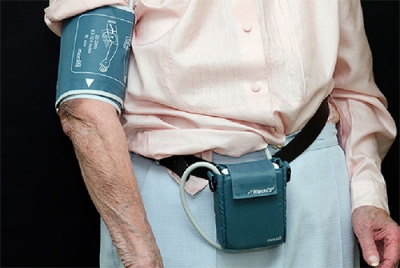Ambulatory blood pressure monitoring (ABPM) is a non-invasive method of obtaining blood pressure readings over a 24-hour period, whilst the patient is in their own environment, representing a true reflection of their blood pressure.
Many studies have now confirmed that blood pressure measured over a 24-hour period is superior to clinic blood pressure in predicting future cardiovascular events and target organ damage.
What does ambulatory blood pressure monitoring involve?
Blood pressure is measured over a 24-hour period, using auscultatory or oscillometry devices, and requires use of a cuff. The monitor takes blood pressures every 20 minutes (less frequently overnight – e.g. one-hourly).
What are the uses of ambulatory blood pressure monitoring?
- To obtain a twenty-four hour record – more reliable than one-off measurements. Cardiologists say that increased blood pressure readings on ABPM are more strongly correlated to end-organ damage than one-off measurements – e.g. left ventricular hypertrophy.
- To detect white coat hypertension.
- It has use in hypertension research – e.g. reviewing 24-hour profile of antihypertensive medication.
- It may have prognostic use – higher readings on ABPM are associated with increased mortality.
- Response to treatment.
- Masked hypertension.
- Episodic dysfunction.
- Autonomic dysfunction.
- Hypotensive symptoms whilst on antihypertensive medications.
- It may be more cost-effective in the long term than office blood pressure measurement.
Who should be referred for ambulatory blood pressure monitoring?
- It is recommended by the heart specialist that if a clinic blood pressure is 140/90 mm Hg or higher, ABPM should be offered to confirm the diagnosis of hypertension. If a person is unable to tolerate ABPM, home blood pressure monitoring (HBPM) is a suitable alternative to confirm the diagnosis of hypertension.
- Poorly controlled hypertension – e.g. suspected drug resistance.
- Patients who have developed target organ damage despite control of blood pressure.
- Patients who develop hypertension during pregnancy.
- High-risk patients – e.g. those with diabetes mellitus, those with cerebrovascular disease and kidney transplant recipients.
- Suspicion of white coat hypertension – high blood pressure readings in clinic which are normal at home.
- Suspicion of reversed white coat hypertension, i.e. blood pressure readings are normal in clinic but raised in the patient’s own environment.
- Postural hypotension.
- Elderly patients with systolic hypertension.






Leave A Comment
You must be logged in to post a comment.